
HILLMAN WWII SCRAPBOOK
HMCS PRINCE ROBERT
Part of the HMCS Prince Robert Tribute
www.hillmanweb.com/rcn
Presents
2.
CNSS PRINCE ROBERT 1930s
A Family of
Princes
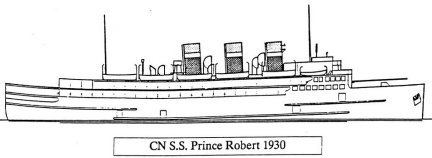

Presents
2.
CNSS PRINCE ROBERT 1930s
A Family of
Princes

The PRINCE ROBERT was the most noteworthy of three of the most unusual ships to sail. She metamorphosed more times than a butterfly. Originally designed as a fast coastal ferry, she later became a cruise ship, an AMC, an A/A cruiser, a refugee transport, and finally, a luxurious ocean liner.She endured more reconstructions and face-lifts than a Hollywood star. But as evidence of her basic speed, strength and endurance, saw more of the world, sailed more operational miles and had longer sea times than any other ship in the RCN. Altogether, the ROBERT served five years as a warship and the best part of 26 additional years as a passenger vessel.
For most of the war it was the largest and most heavily armed ship in the Canadian Navy. However, the lack of protective armour and large interior open space, especially in the engine room, made her particularly vulnerable. From the point of view of her crew, after they had overcome their initial disappointment at not being posted to a “real” warship like a destroyer, she became the luckiest, most comfortable and most interesting berth they ever had.
The Prince Class ships of the RCN in their role as Armed Merchant Cruisers were a surprising success on their first operational cruise. With the main attention on the Atlantic and the European struggle, their Pacific Ocean triumphs didn’t receive a great deal of publicity. By the end of the war, they had completely changed their original naval design and had become as well known to soldiers as to sailors. In the five years of the war, only one, the ROBERT, was engaged in a sea battle, yet the three of them cost the Germans 18,000 tons of shipping.
The ROBERT was one of three ships ordered in one contract in 1929 by Canadian National Steamships, a subsidiary of the CNR, from Cammell Laird, Birkenhead. Sir Henry Thornton, President of the CNR, planned to create a comprehensive service to compete with the well-established CPR Princess ships operating on the West Coast. In fact they were not named after any royal sons but the name “Prince” was appended to a long since forgotten vice president of the CNR and was of course a play on his rivals the CPR’s “Princesses”.
The cost of the ROBERT was over $2,000,000 by the summer delivery date of 1930. The depression was to seriously affect her prewar life, and the costs termed, “Sir Henry’s Last Extravagance” contributed to his eventual resignation in 1932.
It was truly a small luxury liner, designed by A.T. Wall, Liverpool. There was accommodation for 334 first class and 70 third class passengers on three decks, plus cargo space forward. The ROBERT was 385 ft. overall, 57 ft. beam and 20.2 ft. molded depth. Trial draft was 16.6 ft., displacement 5,579 tons, 6,893 gross tonnage, and 3,072 net. It is interesting to note that even after two major conversions, and another postwar, the de-stored draft was still 16.6 ft.
Power of 19,300 IHP at 267 RPM was delivered by Parsons reaction three-stage single reduction geared turbine to twin screws, producing 14,500 SHP and a speed of 23 knots on trial. There were 6 Yarrow water tube boilers, five drum super-heat main boilers, plus two Scotch Marine three burner auxiliary boilers. Endurance was 6000 miles at economical speed and 3500 miles at operating speed of 20 knots.
PRINCE ROBERT was launched April 3rd, 1930 at Cammell Liard and was hull No. 966. It was a fairly high ship with a small enclosed upper wheelhouse. A full width open bridge passed in front of this wheelhouse and this arrangement was duplicated on the boat deck below. The boat deck gave a rather cluttered appearance by today’s standards, with three tall tricolour banded funnels, six lifeboats per side. Two long cargo booms projected over the full length of the forecastle to service No. 1 hold. Since there was no uniformity of jetty height in each port, “shell” doors were let into the hull on each deck, and an internal two-car elevator transferred cars between decks. The ship was elegantly fitted for extended cruising with ornate woodwork in cabins and saloons. The ROBERT was turned over to a locally assigned crew in 1930 within a few months of launching. There was a problem with the high flared bow, which effectively removed many of the dockside CN sheds when the ship approached at too broad an angle.
When the ROBERT arrived on the West Coast in mid 1930 it was immediately placed on the Vancouver-Victoria-Seattle service. The depression removed any chance of using her on the Alaska run. In 1932 the ROBERT made extended cruises to Bermuda and the Caribbean from Boston and New York. She then returned to the Alaska route, which was an 11-day, 2000-mile trip to Skagway via the inside passage, calling at Sitka, Juneau, Ketchikan, and Prince Rupert. She was laid up during the winter months.
By the late 30s, the Canadian Chief of Naval Staff was examining requirements of ships for the imminent war. When the CNR was searching for buyers for their ships during the lean years, he was opposed to their sale outside Canada, foreseeing they would have potential as Armed Merchant Cruisers. The Admiralty had deposited some defensive equipment in Canada to arm AMCs in the event of war. The RCN volunteered to look after arming its own AMCs if the Admiralty would release twelve-inch guns.
With the sailing of convoy HX7 from Halifax on October 31, 1939, AMCs began to undertake the protection of fast convoys. The general rules were that unusually large or valuable convoys would be escorted by battleships, whereas others would be shepherded by cruisers and AMCs supplementing available anti-submarine destroyers to provide a minimum of protection against surface raiders.
With this plan already in hand, the three Princes at once came to mind although conversion to AMCs would be a sizable task. The Minister of Defense had, by September 3rd. the authority to requisition the ships and on the 9th, the message was sent to Admiralty that the ships were available for war use. By the 19th, the War Cabinet had approved the first shipbuilding program of $10,000,000, under which the conversion of the Princes was to come. The Admiralty replied that two could be fitted with their Canadian stored equipment, but looked askance at the Princes because of their limited range, poor water supply, and moderate top speed, and advised the RCN not to take up the third at that time. The two selected were still in CN service, PRINCE ROBERT and PRINCE DAVID.
In Mid-October 1939 proceedings were begun to requisition the two ships on a charter-hire basis. It was soon obvious that the alterations would be substantial, and reconditioning after the war would be substantial, and reconditioning after the war would be expensive. Thus, on December 8th, the Chief of Naval Staff recommended that the ships be bought and even retained after the war. Convinced, the Treasury Board authorized $1,200,000 to buy the two ships. Negotiations then dragged on between the CN and the Navy with a surprising lack of urgency, considering that the war was four months old and known German raiders were at large. The two ships were finally taken over in late January, 1940. The final price agreed upon after prolonged negotiations was $700,000 for the PRINCE ROBERT.
Plans were prepared by Lambert, Germain and Milne for conversion to an AMC and tenders called. The contract for the ROBERT was let to Burrard Dry Dock, Vancouver, for a starting date of February 9, 1940 to be delivered in July for an estimated cost of $654,790, later raised to $755,300. She was commissioned on July 31, 1940.
In the conversion, the top two decks were removed and a light cruiser superstructure fitted, thus removing the boat deck, cabins and lounges. Accommodation was revised, the hull and deck stiffened in places and a small amount of watertight division added. All this proved a real problem at the end of the war when the time came to reconvert to peacetime. Even with this work there was a basic weakness due to the large compartments extending across the ship with open access. A torpedo in the forward hold or the large undivided engine room would have had fatal consequences.
For armament, the ROBERT was equipped with four 6-inch guns, in an “A”, “B” and “X”, “Y” configuration. Two 3 inch guns were fitted on the upper deck amidships plus some 50 caliber machine guns. Two depth charge chutes were added at the stern although there was no Asdic, HFDF or Radar. The guns provided were up to 45 years old, without any semblance of range and fire control equipment! The 6 inch guns had been manufactured as early as 1896 and were to be fitted in the casements of the King Edward class battleships launched 1905/06 and obsolete at the start of World War I. The guns were designed to train over only a small arc which had to be extended to 300 degrees, but training over this arc was sluggish. At times they were assisted by a crew hauling lines attached to the gun muzzles. The 3-inch guns were much more modern, being of 1916 vintage, designed for light cruisers. However ancient this firepower was, it made the Princes the most powerful ships in the RCN. The new funnel arrangements gave the ROBERT a handsome and belligerent appearance resembling a Hawkins class cruiser.
CNSS Prince Robert ~ 1930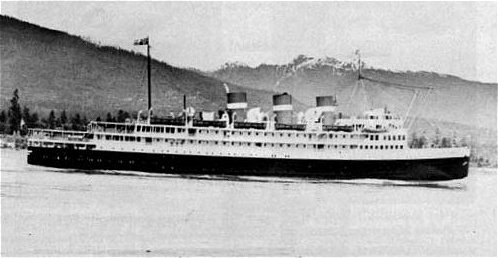
CN Steamship Prince Robert carrying their Majesties King George VI and
Queen Elizabeth from Victoria to Vancouver in the fast time of
3 hours, 32 minutes, June 1939.
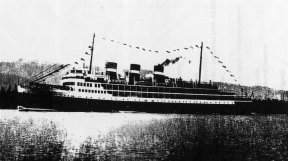
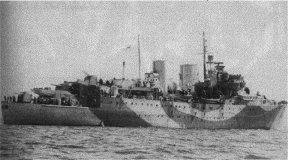
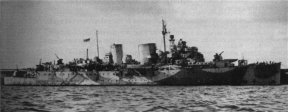
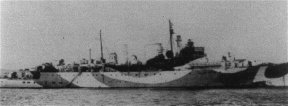
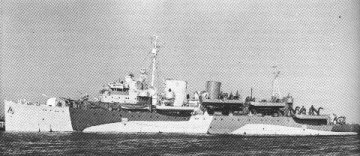
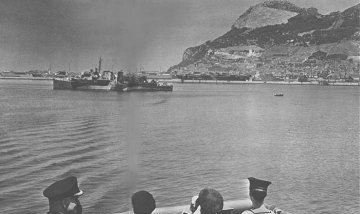
H.M.C.S. Prince David
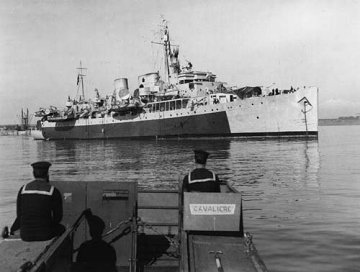
H.M.C.S. Prince Henry
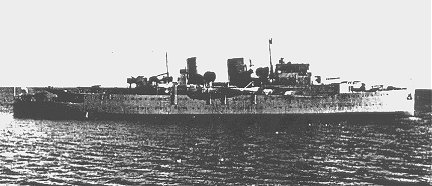
H.M.C.S. Prince Robert
First Conversion 1940



Back to HMCS Prince Robert Tribute
www.hillmanweb.com/rcnWebmaster: William G. Hillman
BILL & SUE-ON HILLMAN ECLECTIC STUDIO
Copyright 2000/2006/2017
Bill Johnson Material Copyright 1988